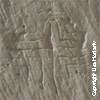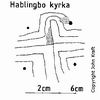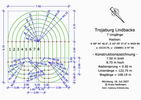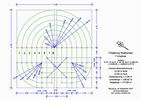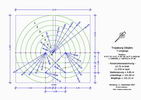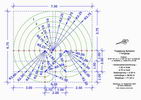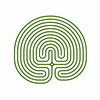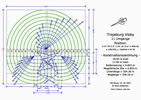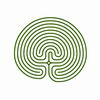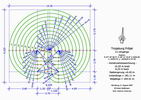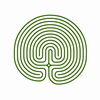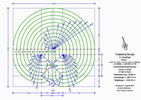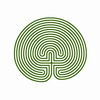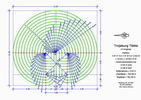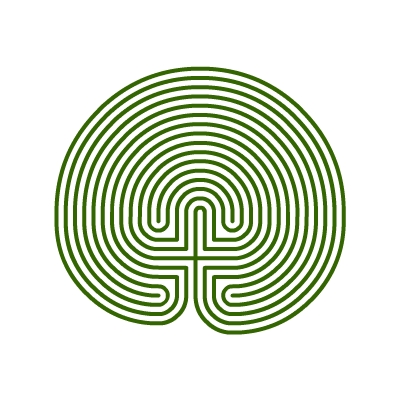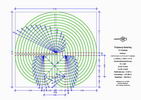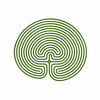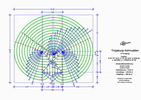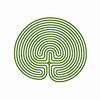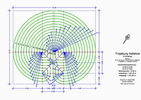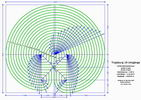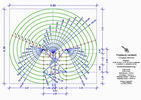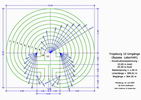|
The Troy Towns
The Scandinavian Troy Towns are very old classical
labyrinths in the shape of stones laid out in free field.
In the following you will see the Swedish labyrinths
with the eyes of a surveyor and civil ingineer. I am interested,
where exactly the labyrinths are situated (by GPS), how they are
looking like nowadays, which is the pattern and geometric design
behind them. Maybe one could call it the search for the ideal line. Is this to high or to simple, to extreme or irrelevant? Form your own opnion.
The pattern
There is at first the well-known pattern to develop the classical
labyrinth (picture 1). This will be the 7-paths labyrinth.
Troy Towns with 7 circuitsTroy Town Lindbacke
The Troy Town Lindbacke lies at Nyköping in the province Södermanlands Län, and is presumably 2500 years old. This classical labyrinth is stretched very strong in the height, and a little bit fewer in the width. Through this the center is very much pointed. Here the drawing as PDF-file > More pictures in the photo gallery under Lindbacke >
Troy Town Majbacken in Petarve
The Troy Town Majbacken lies at Petarve (municipality of Garda) on the island of Gotland, and is approximately 150 years old. This classical labyrinth is stretched a little bit in the height and in the width. It looks somewhat angular. Here the drawing as PDF-file > More pictures in the photo gallery under Majbacken >
Troy Town Dibjärs
The Troy Town Dibjärs lies on the island of Gotland, and is approximately 100 years old. Unfortunately the labyrinth is totally overgrown, and hardly to see. There is need to do something if it shall survive. Here the drawing as PDF-file > More pictures in the photo gallery under Dibjärs >
Troy Town Nyhamn
The Troy Town Nyhamn lies on the island of Gotland, and is approximately 60 years old. The labyrinth is on the beach near to holiday homes, and is obviously visited and maintained by the people. Here the drawing as PDF-file > More pictures in the photo gallery under Nyhamn >
Troy Towns with 11 circuitsTroy Town Visby
The Troy Town Visby lies on the island of Gotland something outside the old Hansa town Visby under the galgberget (gallows hill). This classical labyrinth with 11 circuits is presumably 2500 years old. It is well-known and often visited. One can see that through the years there have been made some short cuts and deviations inside the labyrinth. Curt Roslund (Sweden) sees the labyrinth built in units of the so-called megalithic yard. In the drawing this unit is used to construct the labyrinth. Here the drawing as PDF-file > More pictures in the photo gallery under Visby >
Troy Town Fröjel
The Troy Town Fröjel lies on the island of Gotland inside the graveyard surrounding the church. The 11-paths labyrinth is presumably 2500 years old. In ancient times there was a place of worship for the goddess Freyia (therefore the name Fröjel). In 1974 the labyrinth has been restored. Here the drawing as PDF-file > More pictures in the photo gallery under Fröjel >
Troy Town Bunge
The Troy Town Bunge lies on the island of Gotland on a meadow beside a crossroads near the church, and near the country museum. 100 years ago the labyrinth was laid out by the founders of the museum as a mirrored copy of the Troy Town Visby. Here the drawing as PDF-file > More pictures in the photo gallery under Bunge >
Troy Towns with 15 circuitsTroy Town Tibble
The Troy Town Tibble lies east to the city of Västerås in the province Västmanlands Län, not far away from the grave fields of Badelunda. The 15-paths labyrinth is presumably at least 1500 years old. The entrance is from the west. John Kraft worked for months to uncover the stones sunken to the ground during the centuries. The ZDF (the Second German Television) reported about John Kraft and the Troy Towns in Sweden. Here the drawing as PDF-file > More pictures in the photo gallery under Tibble >
Troy Town Rösaring
The Troy Town Röaring lies in the forests near Låssa in the province Stockholms Län. The 15-paths labyrinth is presumably 2500 years old, and orientated from West to East. It would be very important to restore it, because it is in danger to dissapear. Here the drawing as PDF-file > More pictures in the photo gallery under Rösaring >
Troy Town Holmudden
The Troy Town Holmudden lies on the small island Fårö in the north-east of Gotland not far away from a light house. 15-paths labyrinth is presumably very old. The ground plan shows the center lying under the upper two turning points, so the labyrinth looks somewhat compressed. Here the drawing as PDF-file > More pictures in the photo gallery under Holmudden >
Troy Town Hallshuk
The Troy Town Hallshuk lies above the steep coast of the Baltic Sea near to Hall on the island of Gotland. The classical labyrinth is presumably very old. Here the drawing as PDF-file > More pictures in the photo gallery under Hallshuk >
Troy Town with 19 circuitsTroy Town
I don't know (till now) a Troy Town with 19 circuits. Who will help me?
Or is building one? That would be great. Here the drawing as PDF-file >
Other Troy TownsTroy Town Landsort
This labyrinth lies on the small island of Landsort south of Nynäshamn, and has been restored through John Kraft in 1978. It is presumably very old, and shows a very special design, which one could call competition labyrinth. The central cross is opened, and offers the possibility to go either to the right or to the left. There is a tradition known with two boys running from this point to the center, where a girl awaited the first. Here the drawing as PDF-file > More pictures in the photo gallery under Landsort >
Bypass Labyrinth
About this labyrinth I only know from an article of John Kraft in Gotländskt Arkiv 1983. Two paths are connected in the middle in a way to make the center larger, and to lead the path above the central crossing point and beside the center; creating in this way a bypass. Here the drawing as PDF-file >
Acknowledgements
My special thanks goes to John Kraft, Anita and
Bo Stjernström, whose research made it possible for
me to make the drawings.
A dream
The best way to conserve a labyrinth is to walk it. And this practice and this tradition seems to get lost in Sweden. The Troy Town Rösaring is in need of restoration. What would it mean if the Scandinavian Troy Towns would be inscribed on the UNESCO's list of the World Heritage Sites?
|



